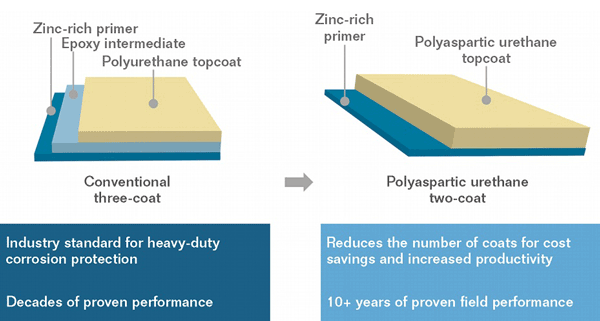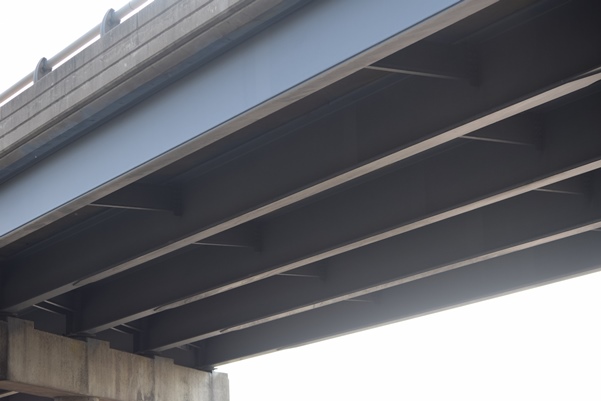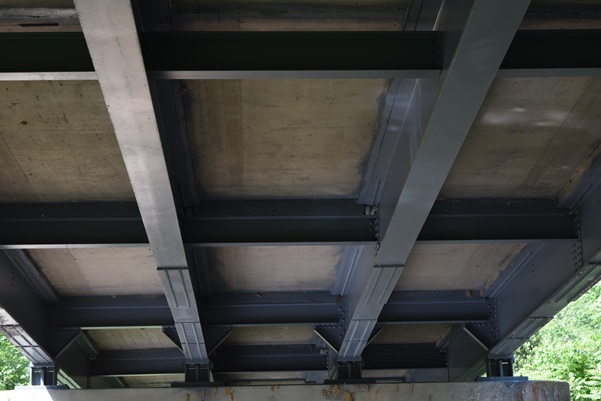Protective coatings have been used for more than a century to protect steel bridges from corrosion. As bridge coating technology continued to evolve in the 1990s, advancements in binder technology allowed a reduction in the number of coating layers from three coats to two through the use of high-build, two-coat polyaspartic urethane (PAS) coating systems.1 The main advantages of PAS coating systems are increased painting productivity and overall cost reduction, with corrosion protection equivalent to conventional three-coat systems.2 PAS two-coat systems utilize a zinc-rich primer for galvanic protection, and the epoxy and polyurethane layers are replaced by a high-build PAS topcoat.
In recent years, a second generation of PAS coatings has been developed to address application issues encountered in warm climates with high humidity. In these conditions, the first generation products had relatively short pot lives and recoat windows. When touch-up of the topcoat was necessary after 24 h from the initial application, abrading between coats was required or delamination of the second layer could occur. Recent advances in PAS resin technology addressed these issues while also improving wet adhesion and corrosion resistance.3

Starting in 2005, the Virginia Department of Transportation (VDOT) allowed PAS two-coat systems to be used in lieu of three-coat systems due to their faster blast/repaint time, which significantly lowers traffic redirection cost.4 Research was conducted to compare the field performance of PAS two-coat systems and three-coat moisture-cure urethane (MCU) systems on steel bridges in western Virginia after 10 years of service. A total of 37 bridges were visually inspected for rusting and overall coating performance to provide statistically significant performance data. Fifteen bridge structures were painted with a PAS two-coat system consisting of a moisture-cure zinc-rich primer/PAS topcoat, and 22 structures were painted with a MCU three-coat system consisting of zinc-rich MCU primer/MCU intermediate/MCU topcoat.
The service conditions for this environment include routine salt application during winter and frequent freeze/thaw cycles during spring and fall seasons, which stress the ability of the coatings to protect the steel. The bridge decks were made of either hydraulic cement concrete or timber. All 13 timber decks were overlaid with asphalt, while only 10 of the 24 concrete decks had an asphalt overlay. Seven timber deck bridges and eight concrete deck bridges were coated with the PAS two-coat system.
All bridges were visually inspected in 2015 to evaluate the performance of the PAS two-coat system after being in service for ~10 years. To make a comparison against three-coat systems, two bridge projects painted in the 2004-2005 timeframe with MCU three-coat systems were also evaluated. The bridge structures were visually inspected and rated using the field guide from Myers, et al.,5 which is a visual guide that provides pictorial examples of each category to aid the user in determining the percentage of rust on a steel bridge during field inspections. The rating system, shown in Table 1, is based on SSPC-VIS 2.6 The rating system was used to rate the beam ends and mid-span. The beam end is the area from the end of the beam up to 12 ft (3.7 m) away from the end, while the mid-span represents the remaining area between the beam ends.

The ratings from three different NACE International-certified Coating Inspectors, Ahren Olson and Todd Williams with Covestro LLC and Mark Hudson with The Sherwin-Williams Co., along with ratings from D. Wayne Fleming, an SSPC-certified Bridge Coating Inspector with the VDOT, were averaged to tabulate the rating results for the bridge structures. For discussion purposes, the bridges are grouped into three categories: concrete deck bridges, timber decks bridges with an asphalt overlay, and truss bridges with a timber deck and an asphalt overlay. All categories had bridges coated with either a PAS two-coat or MCU three-coat system.
The performance of both coatings systems was highly influenced by the bridge deck construction. On the 14 hydraulic cement concrete deck bridges without an asphalt overlay, both the PAS two-coat and MCU three-coat systems performed very well. Upon inspection, these bridges were rated as being in very good or good condition. The hydraulic cement concrete decks were in relatively good condition with deck joints that were intact, and leakage to the underlying steel was assumed to be minimal. Of the 10 bridges with concrete decks that were overlaid with asphalt, nine were rated as being in very good or good condition, and one was rated as fair.

The 16 inspected structures with the MCU three-coat system performed well—four were rated as very good and twelve were rated as good. Based on the current performance of the MCU systems, the bridge structures ranked as very good and good with an additional 10 years would be expected to exhibit between 0.1 to 10% rusting and candidates for spot repair and overcoat. The eight structures with the PAS two-coat system also performed well, with four rated as very good, three rated as good, and one rated as fair. The seven structures rated very good or good are expected to be excellent candidates for overcoating (1 to 10% rusting) after 20 years of service, similar to the concrete decks bridges with a MCU three-coat system. This data set and performance difference margin is large enough to conclude that the performance of the PAS two-coat system is at least equivalent to the MCU three-coat system on similar structures.

Bridges with timber decks had significantly more corrosion along the top and bottom girder flanges than bridges with concrete decks. This result was expected since significant penetration of road salt can occur in deteriorated and cracking asphalt overlays over timber decks. Pretreatment chemicals used to preserve timber also are known to accelerate corrosion.7 These chemicals diffuse out of the wood, and primarily foul the deck fasteners and top girder flanges and accelerate corrosion in those areas. Water penetration further accelerates the diffusion of the treatment chemicals from the timber, which, in combination with road salt contamination, significantly contributes to premature coating failure.
Five timber deck bridges with a MCU three-coat system were rated. One was rated as fair and four were rated as poor. After 20 years of service, these bridge structures would not likely be candidates for overcoating (>10% rusting) and would require a full blast and repaint. The timber deck bridges with a two-coat PAS system also showed significant signs of corrosion, similar to MCU three-coat systems on timber decks. Six bridges in this category were rated, with four rated as fair and two rated as poor. After 20 years of service, the bridges with a PAS two-coat system would not likely be candidates for overcoating (>10% rusting), but would require a full blast and repaint.
Truss structures are difficult to protect since they are designed with significantly more angles and edges, areas that typically exhibit the first signs of corrosion.8 Two truss bridges with a timber deck and an asphalt overlay were studied. One, a pony truss bridge, was painted with a MCU three-coat system and the other, a through-truss bridge, was painted with a PAS two-coat system. For both of these structures, rusting was only rated for the steel above the bridge deck because the MCU-coated bridge was inaccessible from beneath and the PAS-coated bridge had galvanized support girders below the deck. The bridge with the MCU three-coat system was rated as fair and the PAS two-coat through-truss bridge was rated as good.
This research confirms the field performance of PAS two-coat coating systems and further validates the technology’s excellent corrosion prevention noted in many previous investigations. With performance being equal, PAS two-coat systems can provide significant value to bridge owners in the form of overall cost reduction in painting operations, accelerated painting schedules, and milder traffic congestion headaches.
This study also demonstrated that all coatings applied to steel bridges with timber bridge decks provided reduced corrosion protection than the same coatings applied to steel bridges with concrete decks.
References
1 C. Zweiner, et al., “New Concepts for Two-Pack Polyurethane Coatings,” Fabre & Lack 12 (1991): p. 1,052.
2 S.-L. Chong, Y. Yao, “Performance Testing of Two-Coat Zinc-Rich Systems on Steel Bridges,” Journal of Protective Coatings and Linings 6 (2006): pp. 72-83.
3 A. Olson, “Next Generation Polyaspartic Coatings for High Throughput Applications,” presented at CORROSION 2013 (Orlando, FL: NACE International, 2013).
4 C.W. Fleming, Virginia Department of Transportation—Materials Office, e-mail message to author, April 23, 2015.
5 J.J. Myers, G. Washer, W. Zheng. “Structural Steel Coatings for Corrosion Mitigation,” Center for Transportation Infrastructure and Safety/NUTC Program, Missouri University of Science and Technology, Report NUTC R233 & R238, Oct. 2010.
6 SSPC VIS-2, “Standard Method of Evaluating Degree of Rusting on Painted Steel Surfaces” (Pittsburgh, PA: SSPC).
7 S. Zelinka, “Corrosion of Metals in Wood Products,” Developments in Corrosion Protection, M. Aliofkhazrae, ed. (Rijeka, Croatia: InTech, 2014), pp. 567-591.
8 C.G. Munger, L.D. Vincent, “Coating Failures,” Corrosion Protection by Protective Coatings (Houston, TX: NACE, 1999), p. 357.